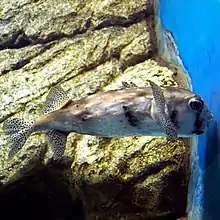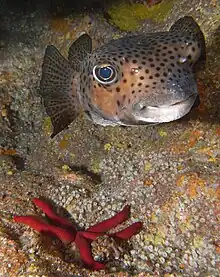| Chilomycterus reticulatus | |
|---|---|
 | |
| Scientific classification | |
| Domain: | Eukaryota |
| Kingdom: | Animalia |
| Phylum: | Chordata |
| Class: | Actinopterygii |
| Order: | Tetraodontiformes |
| Family: | Diodontidae |
| Genus: | Chilomycterus |
| Species: | C. reticulatus |
| Binomial name | |
| Chilomycterus reticulatus | |
| Synonyms[2] | |
Chilomycterus reticulatus, the spotfin burrfish, spotted burrfish, Pacific burrfish, spotfin porcupinefish or few-spined porcupinefish, is a species of fish in the genus Chilomycterus, which is part of the porcupinefish family Diodontidae.[3]
Description
Chilomycterus reticulatus has a rotund body, which can be inflated, with a wide, blunt head and large eyes. The nasal organ of adults sits in an open, pitted cup which in juveniles is a tentacle with two openings. The teeth are fused into a parrot like beak with no frontal groove and the mouth is large. The fins lack spines and there are no pelvic fins, the dorsal fin has 12-14 rays, the anal fin has 11-14 rays, the caudal fin has 10 rays and there are 19-22 rays in the large pectoral fins. The body is covered in small spines which are triangular on cross section, some of which are reduced to plates under the skin. There is a row of 8-10 spines which runs from the head to the dorsal fin, and there are one or two spines on the caudal peduncle.[4]
Adult C. reticulatus are grey to brown in colour with a black gular band and small black spots on upper surfaces and fins. The pelagic juveniles are blue in colour with dark spots above, the spots reaching to the belly.[5] They grow to a standard length of 50 cm but up to 75 cm has been recorded[6][7]

Distribution
Chilomycterus reticulatus is rather patchily distributed in warm temperate seas throughout the world in the Pacific, Atlantic, including the Gulf of Mexico and Mediterranean Sea, and Indian Oceans. In the Atlantic it reaches as far north as North Carolina in the west and Portugal in the east and south to South Africa and Brazil, in the Indo-Pacific it extends north to Japan and south to northern New Zealand and in the eastern Pacific it is found from Chile north to California.[5][1]
Biology
Chilomycterus reticulatus is found among coral and rocky reefs at depths down to 140m, but has also been caught in trawls over softer substrates. It is normally found at depths of less than 25m and it feeds mainly on hard shelled invertebrates, including molluscs, echinoderms and crustaceans. They eggs and larvae are pelagic, juveniles are often found among floating weed mats and become demersal at around 20 cm. The adults are active by day and at night they sleep braced against the substrate. They are frequently encountered washed up on beaches.[4][8][7]


References
- 1 2 J.L. Leis; K. Matsuura; K.T. Shao; et al. (2017) [errata version of 2015 assessment]. "Chilomycterus reticulatus". IUCN Red List of Threatened Species. 2015: e.T193752A115331266. doi:10.2305/IUCN.UK.2015-4.RLTS.T193752A2271648.en. Retrieved 16 March 2022.
- ↑ "Synonyms of Chilomycterus reticulatus (Linnaeus, 1758)". Fishbase.org. Retrieved 12 February 2017.
- ↑ "Common names of Chilomycterus reticulatus". Fishbase.org. Retrieved 12 February 2017.
- 1 2 "Chilomycterus reticulatus". Encyclopedia of Life. Retrieved 12 February 2017.
- 1 2 Pascualita Sa-a; Estelita Emily Capuli (2016). R. Froese; D. Pauly (eds.). "Chilomycterus reticulatus (Linnaeus, 1758)". Fishbase. Retrieved 12 February 2017.
- ↑ J.C. Hureau. "Chilomycterus atringa". Marine Species Identification Portal - Fishes of the NE Atlantic and Mediterrarean. ETI Bioinformatics. Retrieved 12 February 2017.
- 1 2 "Chilomycterus reticulatus (Linnaeus, 1758)". Discover Life. Retrieved 12 February 2017.
- ↑ "Spotfin Porcupinefish, Chilomycterus reticulatus (Linnaeus 1758)". Fishes of Australia. Museums Victoria. Retrieved 12 February 2017.
External links
- Photos of Chilomycterus reticulatus on Sealife Collection
